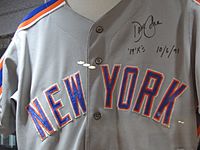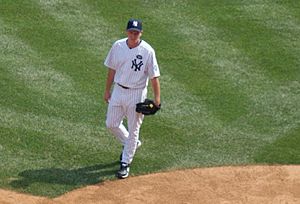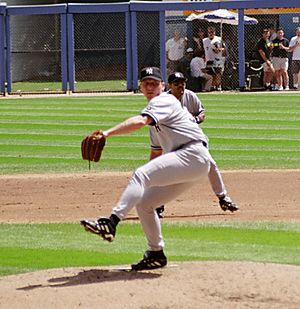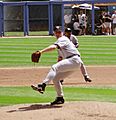David Cone facts for kids
Quick facts for kids David Cone |
|||
|---|---|---|---|

Cone in 2009
|
|||
| Pitcher | |||
| Born: January 2, 1963 Kansas City, Missouri, U.S. |
|||
|
|||
| debut | |||
| June 8, 1986, for the Kansas City Royals | |||
| Last appearance | |||
| May 28, 2003, for the New York Mets | |||
| MLB statistics | |||
| Win–loss record | 194–126 | ||
| Earned run average | 3.46 | ||
| Strikeouts | 2,688 | ||
| Teams | |||
|
|||
| Career highlights and awards | |||
|
|||
David Brian Cone (born January 2, 1963) is an American former Major League Baseball (MLB) pitcher. He is currently a baseball commentator for the New York Yankees on the YES Network and Amazon Prime, and for ESPN on Sunday Night Baseball.
David Cone was chosen by the Kansas City Royals in the third round of the 1981 MLB draft. He started playing in the MLB in 1986 and continued until 2003. During his career, he pitched for five different teams. Cone batted left-handed but threw the ball with his right hand.
In the final game of the 1991 season, Cone achieved an amazing feat by striking out 19 batters. This tied for the second-highest number of strikeouts ever in a single game. He was well-known for his split-finger fastball pitch. Cone won the 1994 American League Cy Young Award, which is given to the best pitcher. He was also selected as an All-Star five times. From 1990 to 1992, he led all of Major League Baseball in strikeouts.
Cone was a "20-game winner" twice, meaning he won 20 games in a single season. He set an MLB record for the longest time between his two 20-win seasons, with 10 years in between. In 1999, Cone pitched the sixteenth perfect game in baseball history.
He was part of five World Series championship teams. He won in 1992 with the Toronto Blue Jays. Then, he won four more times with the New York Yankees in 1996, 1998, 1999, and 2000. In his postseason career, he had a record of 8 wins and 3 losses over 21 games. His earned run average (ERA) in the postseason was 3.80, and in the World Series, it was even better at 2.12.
David Cone is featured in the book A Pitcher's Story: Innings With David Cone by Roger Angell. He also co-wrote his own autobiography, Full Count: The Education of a Pitcher, with Jack Curry. This book was released in May 2019 and quickly became a New York Times Best Seller.
Contents
- Early Life and Baseball Beginnings
- Playing in the Major Leagues
- Starting with the Kansas City Royals (1981–1986)
- Becoming a Star with the New York Mets (1987–1992)
- Winning a World Series with the Toronto Blue Jays (1992)
- Back with the Kansas City Royals (1993–1994)
- Another Stint with the Toronto Blue Jays (1995)
- Becoming a Yankee Legend (1995–2000)
- Playing for the Boston Red Sox (2001)
- Returning to the New York Mets (2003)
- Pitching Style
- Career Achievements
- After Playing Baseball
- Personal Life
- See also
- Images for kids
Early Life and Baseball Beginnings
David Cone was born in Kansas City, Missouri. His parents were Joan and Edwin Cone. He went to Rockhurst High School, where he was a talented athlete. He played quarterback for the football team, helping them win a district championship. He was also a point guard on the basketball team.
Since his high school didn't have a baseball team, Cone played summer baseball in the Ban Johnson League. This was a college summer league in Kansas City. When he was 16, he tried out for the Kansas City Royals and the St. Louis Cardinals. He also received offers to play both college football and baseball. After graduating, he decided to attend the University of Missouri. He was then drafted by his hometown Kansas City Royals in the third round of the 1981 Major League Baseball draft.
Playing in the Major Leagues
Starting with the Kansas City Royals (1981–1986)
In his first two years as a professional baseball player, David Cone had a great start. He won 22 games and lost 7, with a low earned run average (ERA) of 2.21. He missed the 1983 season due to an injury. When he returned in 1984, he played for the Double-A Memphis Chicks.
In 1986, while playing for the Class AAA Omaha Royals, Cone changed his role to a relief pitcher. He made his first Major League appearance on June 8, 1986, coming in to pitch after Cy Young Award winner Bret Saberhagen. After a few more games with the Royals, he returned to Omaha. He finished the season strong there, with 8 wins and 4 losses and a 2.79 ERA. He rejoined the Kansas City team in September when teams could add more players.
Becoming a Star with the New York Mets (1987–1992)
Before the 1987 season, Cone was traded to the New York Mets. In his first year in New York City, he had 5 wins and 6 losses with a 3.71 ERA. He also recorded 68 strikeouts in 21 games, 13 of which he started.
Cone began the 1988 season pitching from the bullpen. However, by May, he became a starting pitcher. His first start was a complete game shutout against the Atlanta Braves. He had a fantastic first half of the season, with 9 wins and 2 losses and a 2.52 ERA. This earned him his first selection to the All-Star team. For the entire 1988 season, Cone finished with an impressive 20 wins and 3 losses, along with a 2.22 ERA. He placed third in the voting for the National League Cy Young Award.
The Mets won their division easily in 1988. They were expected to win against the Los Angeles Dodgers in the 1988 National League Championship Series. Cone wrote a newspaper column during the playoffs. After the Mets won Game 1, he made some comments about the Dodgers' pitchers. This motivated the Dodgers, and they scored five runs against Cone in Game 2. The Mets then asked Cone to stop writing his column. He pitched well later in the series, but the Dodgers ultimately won and advanced to the 1988 World Series.
On April 30, 1990, in a game against the Atlanta Braves, a mistake happened. Cone was covering first base on a throw, and the umpire mistakenly called the runner safe. Thinking the game was paused, Cone held the ball, and two Braves runners scored.
Cone played for the New York Mets for over five seasons. He was often one of their top pitchers, along with Dwight Gooden. He led the National League in strikeouts in both 1990 and 1991. In 1991, Cone changed his uniform number to 17 to honor his former teammate Keith Hernandez. On August 30, he struck out all three batters in the fifth inning on just nine pitches. This rare achievement is called an immaculate inning.

On October 6, 1991, in the last game of the season, Cone tied a National League record. He struck out 19 batters from the rival Philadelphia Phillies in a 7–0 shutout game. His 19 strikeouts were the second-highest total ever in a nine-inning game, tying Tom Seaver's team record.
Cone was the only Mets player chosen for the 1992 Major League Baseball All-Star Game. At the All-Star break, he had 9 wins and 4 losses with a 2.56 ERA. The Mets were not doing well that season. On August 27, 1992, they traded Cone to the Toronto Blue Jays for Jeff Kent and Ryan Thompson.
Winning a World Series with the Toronto Blue Jays (1992)
After joining Toronto, Cone had 4 wins and 3 losses with a 2.55 ERA. He also had 47 strikeouts with the Blue Jays. When combined with his 214 strikeouts from the Mets, his total of 261 strikeouts led all of Major League Baseball that year, which was a career high for him. Cone went to the postseason for the second time in his career as the Blue Jays won their division.
The Blue Jays defeated the Oakland Athletics in the 1992 American League Championship Series. Then, they beat the Atlanta Braves in the World Series. This gave Cone his first World Series ring and made the Blue Jays the first Canadian team to win the World Series. Cone's record in the postseason was 1 win and 1 loss with a 3.22 ERA.
Back with the Kansas City Royals (1993–1994)
Cone returned to his hometown team, the Kansas City Royals, as a free agent for the 1993 season. Even though his record was 11 wins and 14 losses, he pitched very well. He threw 254 innings with a 3.33 ERA. In the 1994 season, which was shortened by a strike, he improved to 16 wins and 5 losses with a 2.94 ERA. This performance earned him the American League Cy Young Award.
Another Stint with the Toronto Blue Jays (1995)
Four days after the baseball strike ended, the Royals traded Cone back to the Blue Jays. Cone had 9 wins and 6 losses with a 3.38 ERA for Toronto. However, the Blue Jays were not doing well as a team. On July 28, 1995, the Blue Jays traded Cone to the New York Yankees.
Becoming a Yankee Legend (1995–2000)
When the Yankees got Cone, they were on a winning streak. Cone quickly became their top pitcher. He finished the season with 9 wins and 2 losses, helping the Yankees make the playoffs as a wild card team. In his third postseason, Cone won the first game of the 1995 American League Division Series against the Seattle Mariners. The Mariners eventually won the series and eliminated the Yankees.
The Yankees signed Cone to a new contract for three years. In 1996, Cone was diagnosed with an aneurysm in his arm and missed most of the year. When he returned in September, he pitched a no-hitter for seven innings before leaving the game due to pitch count limits.
The Yankees made the playoffs again in 1996. Cone pitched well in Game 3 of the World Series against the Atlanta Braves. He pitched six innings and gave up only one run, helping the Yankees get their first win of the series. The Yankees went on to win their first World Championship in 18 years.
In 1998, Cone had an outstanding season with 20 wins and 7 losses. He set a Major League record for the longest time between two 20-win seasons, with 11 years. Cone helped the Yankees win their playoff series against the Rangers and the Indians. He also won Game 3 of the 1998 World Series against the San Diego Padres. The Yankees won the World Series again. Cone finished fourth in the voting for the AL Cy Young Award.
Cone signed another contract with the Yankees for the 1999 season. He had 12 wins and 9 losses that year. On July 18, he pitched the sixteenth perfect game in baseball history against the Montreal Expos. This was a very special game because it was "Yogi Berra Day" at Yankee Stadium. Yogi Berra, a Yankees legend, caught the ceremonial first pitch from Don Larsen, who also pitched a perfect game for the Yankees in the 1956 World Series. After Cone's perfect game, Larsen and Berra congratulated him.
After his perfect game, Cone's pitching seemed to become less effective. In 2000, he had the worst record of his career, with 4 wins and 14 losses, and a high ERA of 6.91. Despite this, he was brought in to pitch in Game 4 of the 2000 World Series against the Mets. He faced one batter and got him out.
Playing for the Boston Red Sox (2001)
After the 2000 season, Cone knew his time with the Yankees was over. In 2001, Cone pitched for the rival Boston Red Sox. He had a mixed but mostly positive season, with 9 wins and 7 losses and a 4.31 ERA. One notable game was a 1–0 loss against Yankees ace Mike Mussina. Cone pitched 8 and 1/3 innings, giving up only one unearned run. Mussina came very close to pitching a perfect game in that match.
Returning to the New York Mets (2003)
Cone did not play in the 2002 season. However, he tried to make a comeback with the Mets in 2003. Cone had 1 win and 3 losses in four starts for the Mets, with a 6.50 ERA. He announced his retirement soon after his last game on May 28, saying he had a chronic hip problem.
Pitching Style
David Cone based his pitching style on that of Luis Tiant. By copying Tiant's way of pitching, it helped Cone protect his arm. However, this style put a lot of stress on his hips.
Career Achievements
David Cone's career statistics show how great of a pitcher he was:
- His winning percentage of .606 ranks among the top pitchers in MLB history.
- He allowed 7.77 hits per nine innings pitched, which is also a very good ranking.
- He had 8.28 strikeouts per nine innings pitched, ranking him 17th all-time.
- His 2,668 career strikeouts rank 21st in MLB history.
- He started 419 games, ranking 97th all-time.
More of Cone's achievements:
- He is the New York Yankees' all-time leader in strikeouts per 9 innings pitched (8.67).
- He holds the New York Yankees' single-season record for most strikeouts per 9 innings pitched (10.25 in 1997).
- He struck out 19 batters in one game on October 6, 1991.
- He is the only pitcher to have a 20-win season with both the Mets (1988) and the Yankees (1998).
After Playing Baseball

After retiring from baseball in 2001, Cone became a baseball analyst for the YES Network. However, when he tried to make a comeback with the Mets in 2003, the Yankees' owner, George Steinbrenner, was not happy. Cone was told he would not be welcomed back to the YES Network at that time. After his second retirement from playing, Cone was offered a broadcasting job with the Mets, but he turned it down.
In 2008, Cone rejoined the YES Network as an analyst. He left again in 2009–10 to spend more time with his family. On April 19, 2011, Cone returned to the Yankees broadcast booth. He is now the Yankees' main baseball analyst, working alongside former teammate Paul O'Neill and play-by-play announcer Michael Kay. He is known for using advanced baseball statistics in his commentary.
Since the 2021 season, Cone has been co-hosting a podcast called "Toeing the Slab" with Justin Shackil for Jomboy Media. In 2022, Cone also joined the Sunday Night Baseball broadcast team on ESPN.
On July 17, 2009, Cone spoke as a witness before the Senate Judiciary Committee. This was during the Supreme Court nomination hearings for Judge Sonia Sotomayor. Cone read a statement supporting Sotomayor's nomination. He talked about the baseball labor dispute of 1994 and how Judge Sotomayor's decision helped bring the players and owners back to negotiations. Cone said that it's good to have a judge who understands that the law also involves real-life situations.
Personal Life
David Cone married Lynn DiGioia in November 1994. They had a son named Brian in March 2006. David and Lynn Cone divorced in 2011. Cone's current partner is Taja Abitbol. They have a son named Sammy, who was born in December 2011.
See also
- Kansas City Royals award winners and league leaders
- List of athletes who came out of retirement
- List of Major League Baseball career strikeout leaders
- List of Major League Baseball no-hitters
- List of Major League Baseball perfect games
- List of Major League Baseball single-game strikeout leaders
- List of New York Yankees no-hitters
- List of people from Kansas City, Missouri
- List of World Series starting pitchers
Images for kids





